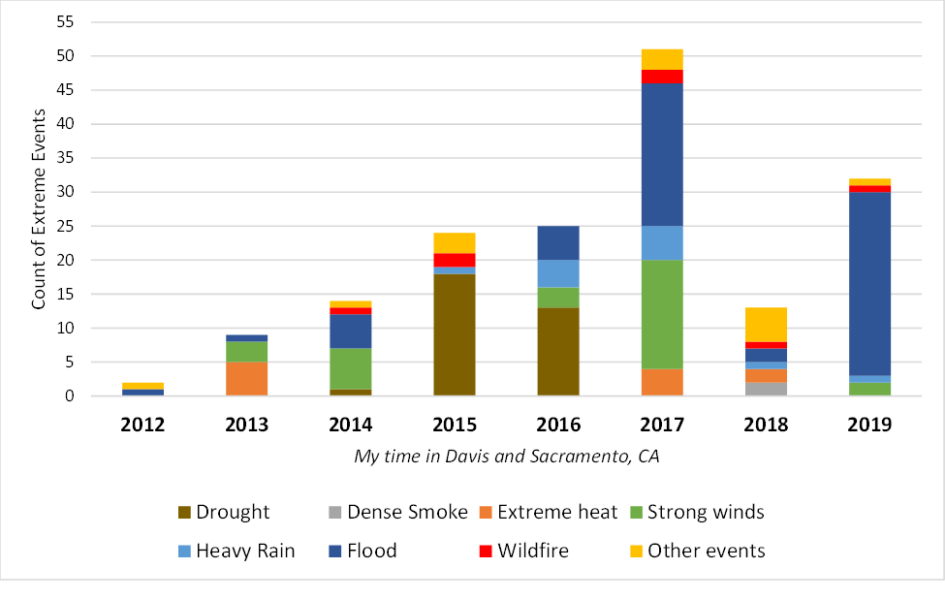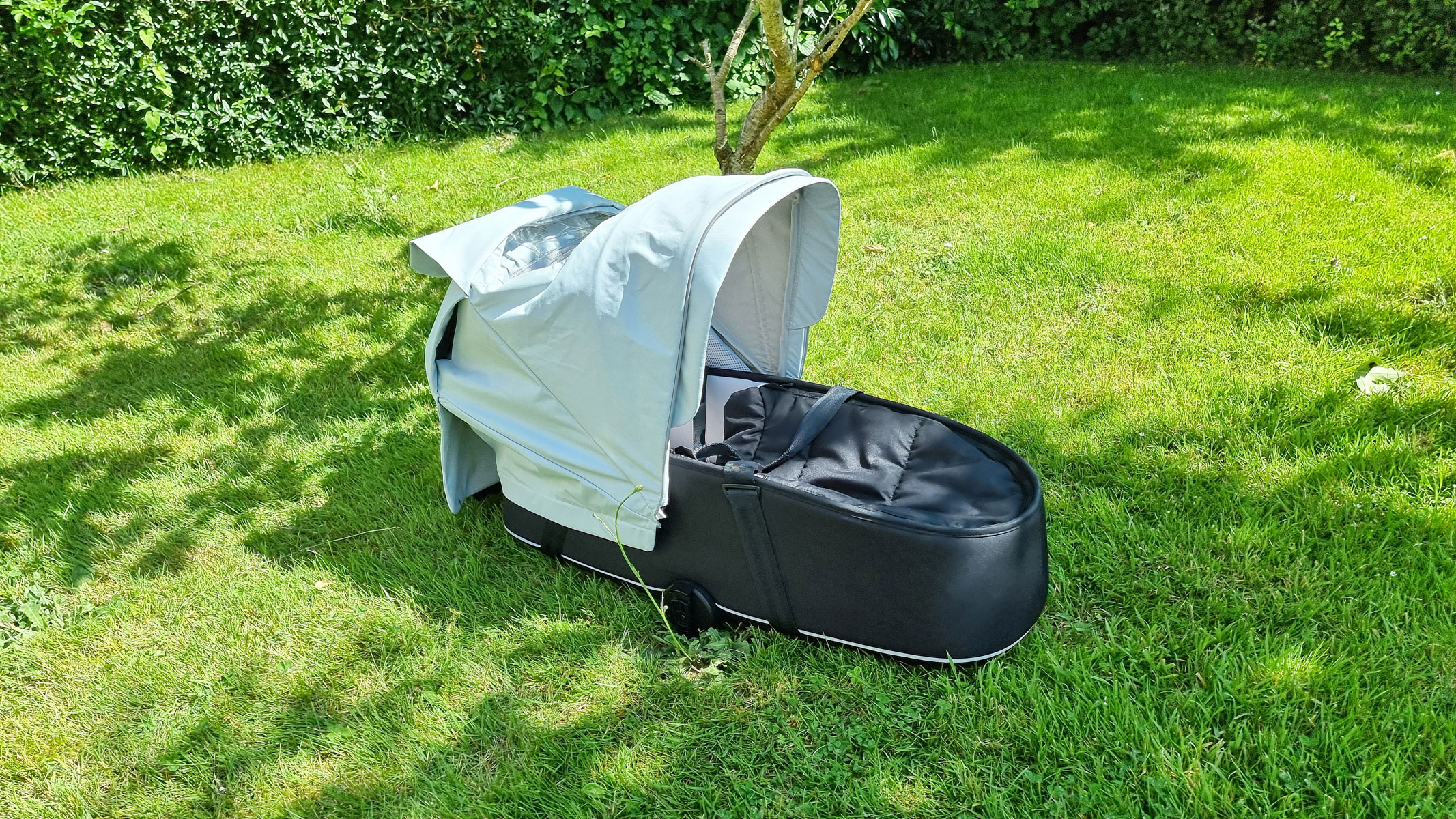Scientific evidence is clear that climate change is affecting winter storms, making extreme events happen more frequently. I lived through one of these storms recently in Texas: Winter Storm Uri in February 2021, which had me juggling microwaving food and charging devices as the local utility imposed rolling blackouts during the freeze.
Before Texas, I lived in California for eight years and experienced 170 different extreme events between Yolo and Sacramento Counties (see my chart below): including the multi-year epic drought and a rainy season that nearly took down a dam. Like most older millennials, climate change has shaped my time on planet Earth.
 Count of extreme events in Yolo and Sacramento counties from Sept 2011 to July 2019. Data: NOAA 2023.
Count of extreme events in Yolo and Sacramento counties from Sept 2011 to July 2019. Data: NOAA 2023.It has also shaped my career choice. As a new Senior Climate Scientist at UCS, it’s my job to pay attention and connect dots between climate and weather as well as between impacts and adaptation.
But does the public similarly recognize climate impacts on their lives, particularly on their household water supplies?
This was the question my colleagues and I asked in a recent survey of more than 700 Californians on a range of water topics. We wanted to understand what motivates Californians to be receptive to local adaptation decisions.
In an open-access academic paper just published in Climatic Change, my co-authors and I analyzed the responses to two specific survey questions:
- Has your household water supply been impacted by an extreme weather event in the last five years?
- To what extent do you agree with the following statement: “I am concerned about California’s water supply reliability due to future extreme weather events (e.g., droughts, wildfires, heat waves, floods).”
Research shows that individual households will increasingly experience climate-exacerbated water insecurity, so understanding individuals’ experiences with climate and perceived future climate risks to their household water security is crucial for decision makers seeking support for adaptation investments. Adaptation investments can be costly, especially in the water sector. New supply projects and conservation or demand management programs are examples of the type of adaptation projects that could strain water systems and state budgets.
In our analysis, we linked Californians’ survey-reported personal experiences of supply impacts and concern about future supply reliability with their recent exposure to extreme event hazards (2016–2021) and projections of future climate hazards (2035–2064). Then we modeled whether and how personal experience and hazard exposure influence their reported concern about future water supply reliability.
In other words, does experiencing extreme events change how people feel about the need for more adaptive water projects?
Survey says: climate impacts to household water supply are a common experience
More than one-third of Californians report experiencing climate change impacts on their household water supplies. Most of the experiences are with drought impacts, which makes sense given that the survey was administered in April 2021.
The map below shows the location of survey respondents based on their reported extreme events impacts to household water supplies for three event types: drought, wildfire, and heatwaves.
 Map of survey responses by the most frequently reported extreme event type: a) drought; b) wildfire; c) heatwaves. Source: Dobbin et al. 2023.
Map of survey responses by the most frequently reported extreme event type: a) drought; b) wildfire; c) heatwaves. Source: Dobbin et al. 2023.Most (85%) survey respondents are concerned about California’s future water supply reliability. More than half, 52%, “agreed” and 33% “strongly agreed” with being concerned.
Geographically, there is little difference between those who agree and disagree with the question’s statement. Yet reporting one or more extreme event impacts on water supply is significantly associated with increased concern about future water supply reliability.
Our analysis controlled for socioeconomic differences, like income and education, factors known to be associated with concern about water security under climate change. We found significant differences across race and gender. Latino and Asian American Pacific Islander respondents more frequently reported being impacted than other ethnicities and racial groups. Fewer men reported impacts to household supplies compared to women. Despite making up a very small sample in our data, genderqueer and non-binary individuals reported the highest rates of household water supply impacts. If a larger study confirmed this trend, it would further underscore the unique vulnerabilities that the LGBTQ+ community face with respect to disasters as shown by a recent US focused study.
Experiencing extreme weather events affects how concerned residents are about future water supply reliability. People who reported at least one extreme event impact to their household water supply were nearly 150% more likely to be in a higher category of concern and were 50% more likely to strongly agree with concerns about future water supply reliability than people who did not report an impact.
And the effects were cumulative: the more extreme events someone experienced, the more concerned they were, with each additional event increasing their odds of being more concerned by more than 80%.
We found that different climate events had different effects on people’s concern about future water supply reliability. Experiencing drought increased the odds of being more concerned by 167%, while experiencing heat increased the odds by 59%. For landslides and other events (e.g., power outages), the odds of being more concerned were even higher at 383% and 249%, respectively. You can check Figure 2 and Table 2 in the paper for more details.
However, we also found that some extreme weather events like wildfires and floods had the opposite effect. For those who reported wildfire impacts, the odds of being more concerned decreased by 26%, and for floods, the odds decreased by 54%.
The differences between event experiences and concern could indicate how individuals understand an extreme event’s relationship to future supply reliability. For example, intuitively, flooding may suggest more reliable future supply even though it actually still poses challenges. Wildfires, because they often are followed by floods, can lead to mudslides and landslides—yet these events individually affected concern in different directions. More work is needed to understand how separate but intersecting extreme events shape concern for future water reliability.
Can an increased concern about water supplies push rapid adaptation forward?
Most Californians are served by a water system that offers some level of protection from extreme events. Yet when the impacts are too extreme or outsized for a system’s ability to adapt and mitigate, communities may have to rely on bottled water and hauled water deliveries, affecting household water security. While climate change awareness is relatively high among California’s drinking water system managers and residents alike, proactive adaptation has lagged especially by smaller providers. And climate adaptation is essential for the Human Right to Water.
Up and down the water supply chain, all of us need to be thinking about how adaptation will take place as climate change affects our drinking water resources. System managers need the support of their customers to adopt and implement adaptation strategies. Local, regional, and state governments, water managers and decisionmakers all need to concern themselves with how and whether residents perceive climate risks. However, our research shows that decisionmakers should not assume that all extreme events will promote concern among individuals in the same way or to the same degree.
Our study demonstrates how personal experiences with extreme events affect perceptions of climate risks to water supplies, reminding us it is important to listen to the people who have experienced climate impacts as they will be the best advocates for future-proofing California’s water management system.

 1 year ago
72
1 year ago
72


